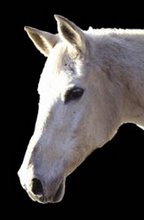So, I did some research, and found cool articles like this one, and discovered that at it's most basic, the principles of hay-making are, well, basic!
1. Cut grass at the right stage of growth.
2. Leave it out to dry (which means rain is not good!) for a couple days, until it reaches the right stage of dry vs. moisture. Don't dry it to a crisp, of course.
3. Halfway through the drying, fluff it up and turn it over. This is called "tedding." Think of it as turning a pancake over so the heat spreads evenly through it.
4. When the hay is dry, store it in a covered, dry space until you need it.
Of course, these are very basic tips, and people can and do write huge books about haymaking techniques, but don't get overwhelmed! I think experimenting is fun, and nothing has to be "perfect" when you're learning. :-D
So, we cut a bagful of green grass, and spread it out to dry for a few days. A day and a half after we cut it, we "tedded" it. (I keep thinking of a teddy bear's fur, for some reason!) About a day after that, I compared it with the baled grass hay I have, and sure enough it looked, felt, and smelled "done." It is not great hay, but it's not bad either!
Here is a picture of our Tiny Hay Bundle:

Hopefully this will give you some inspiration if you have ever wondered if it was possible to grow some of your own animal feed without buying expensive machinery and doing hours of hard labor!
And, please tell me about experiments you have done along these lines!
L
More on Tiny-Scale Sustainability: Management-intensive Grazing, Part 1, Part 2, and Part 3.


No comments:
Post a Comment